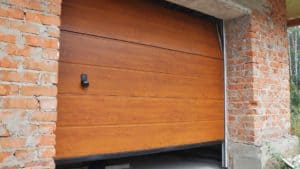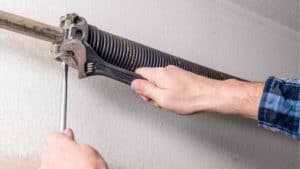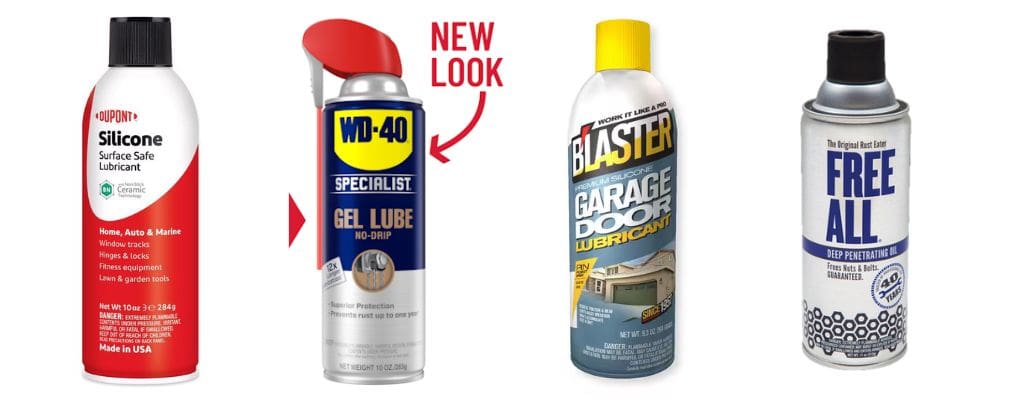
Maintaining a smooth-operating garage door is essential for both the longevity of your door mechanism and your daily convenience. A critical part of this maintenance involves the application of a high-quality lubricant to reduce friction and wear. In this article, we delve into the top garage door lubricants of 2023, evaluating them based on their performance, cost-effectiveness, and suitability for different weather conditions. Our picks cater to various needs and budgets, ensuring you find the perfect solution for your garage door maintenance.

1. Gasoila Free All Rust Eater Deep Penetrating Oil (Best Overall)
Gasoila Free All Rust Eater Deep Penetrating Oil stands out as the best overall choice for garage door lubrication this year. This product shines in its capability to dissolve rust effectively while penetrating deeply to lubricate garage door components, ensuring a smooth operation.
Pros
- Excellent rust dissolving capability
- Deep penetration
- Long-lasting lubrication
Cons
- May require more frequent application compared to other products
Customer feedback: Users appreciate its effectiveness in both lubricating and combating rust, making garage door operation smoother. It has shown remarkable results in loosening rusted or stuck bolts, nuts, and fittings, with some customers suggesting it outperformed other popular products like WD-40 in some cases.
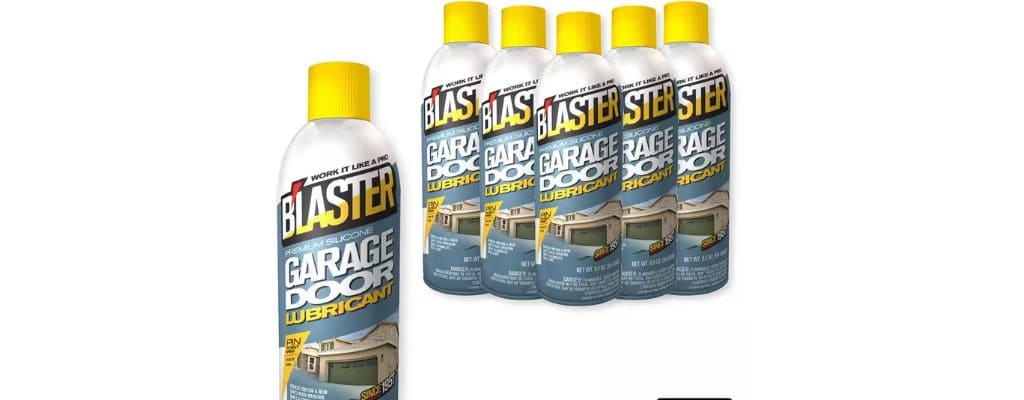
2.Blaster Chemical Company 9.3 Oz Garage Dr Lube (Best Budget)
The Blaster Chemical Company provides a premium silicone-based lubricant designed to eliminate squeaky garage doors and prevent rust and corrosion, reducing friction and wear on garage door mechanisms like rollers, hinges, springs, and door tracks
Pros
- Reduces friction and wear
- Quiets noisy operation
- Doesn’t accumulate dust and dirt
Cons
- Requires regular application for continued performance
Customer feedback: The product has a rating of 4.6 out of 5 stars from 627 reviews, with 93% of the reviewers recommending the product.
3. Mission Automotive Silicone Paste (Best Lubricating Grease)
Mission Automotive Silicone Paste is a dielectric grease used for a variety of applications, including garage door lubrication. It can also be used for battery terminals to prevent oxidation, among other uses.
Pros
- Versatile usage including on garage door components and electrical connections.
- Provides good thickness and consistency for lubricating and protecting surfaces.
- Can be used to waterproof marine and automotive connections.
Cons
- Might be priced higher compared to other lubricating greases.
- The thickness of the paste may require effort in application.
Customer Feedback
Customers appreciate its effectiveness in preventing oxidation and ensuring smooth operation of mechanical parts.
Some users have mentioned that it’s a must-have for marine and automotive wiring and connections.
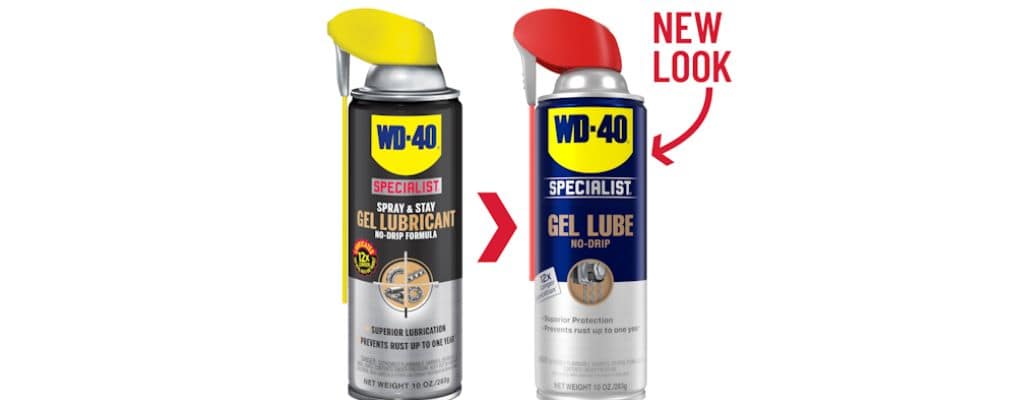
4.WD-40 Specialist Gel Lube (Best for Cold Weather)
WD-40 Specialist Gel Lube is a distinctive no-drip formula lubricant tailored for vertical surfaces and moving parts, boasting 12 times longer-lasting lubrication compared to the WD-40 Multi-Use Product. Its gel consistency ensures it stays where you spray it, making it ideal for overhead applications.
Pros
- Provides exceptional no-drip lubrication
- Perfect for vertical and overhead applications
- Promises longer-lasting lubrication, reducing the frequency of re-application
Cons
- Possible higher price point due to specialized formula
Customer feedback
The product enjoys a stellar rating of 4.7 from 377 reviews, with a whopping 98% of customers recommending it, underscoring its effectiveness and reliability in cold weather conditions.

5. DuPont Teflon Silicone Lubricant Aerosol Spray (Honorable Mention):
DuPont Teflon Silicone Lubricant Aerosol Spray is a high-performance lubricant formulated with Teflon fluoropolymer which helps to outperform other silicone sprays in terms of longer lubricant life, enhanced wear protection, and better high and low temperature range performance. This silicone-rich formula is a great all-purpose lubricant around the home, shop, and worksite. It’s ideal for use on treadmills, sliding parts, windows, doors, rubber door gaskets, and much more.
Pros
- Enhanced wear protection due to Teflon fluoropolymer formulation.
- Long-lasting lubrication.
- Versatile for a variety of applications around home and work areas.
- Good performance across a wide temperature range.
Cons
- Might be priced higher compared to other silicone sprays.
- The aerosol spray may not be ideal for precise application.
Customer Feedback
- Customers have found it to be effective for quieting squeaks and easing the movement of sliding parts.
- It has been appreciated for its long-lasting lubrication and versatility in applications.
For more detailed information and user reviews, you may wish to visit retail platforms like Amazon, Walmart, or hardware stores where the product is sold.
When scouting for garage door insulation, several factors come into play to ensure you make an informed decision. The R-Value is crucial as a higher value signifies better thermal resistance. The material type—be it reflective foil, foam board, or batt insulation—will depend on your local climate and personal preferences. Ease of installation, cost, aesthetics, and durability are other vital considerations.
Moreover, in a time where environmental conservation is paramount, opting for eco-friendly insulation materials can also be a key consideration. All these factors intertwined will guide you in selecting the insulation that aligns with your needs and circumstances.
Keep reading to see what type of insulation is best for you!

Reflective Foil Insulation
Reflective foil insulation, also known as radiant barrier insulation, is designed to reflect radiant heat rather than absorbing it. It’s usually made from aluminum foil backed onto paper or plastic, and is installed in a way that faces an airspace to reflect radiant heat away from a living space or a garage, thereby keeping the area cooler in summer and warmer in winter. This type of insulation is especially effective in hot climates where it can significantly reduce cooling costs.
Top Reflective Foil Product
The SmartGARAGE Reflective Garage Door Insulation Kit is designed to reflect 95% of radiant heat, effectively insulating your garage to keep it warmer in winter and cooler in summer. The kit includes four rolls of reflective foil, which are easy to install with the included double-sided adhesive tape. By insulating your garage with the SmartGARAGE kit, you can create a more comfortable environment and potentially lower your energy bills.
Pros of Reflective Foil Insulation
Reflective foil insulation has several pros:
- Reflects Radiant Heat: Effectively reflects a significant portion of radiant heat to maintain a comfortable temperature.
- Energy Efficiency: Can help reduce energy costs by minimizing heat gain or loss.
- Lightweight: Easy to handle and install due to its lightweight nature.
- Versatile: Can be used in various parts of a home or building, including garages, attics, and walls.
- Moisture Resistant: Often resists moisture which can be beneficial in humid or damp conditions.
Cons of Reflective Foil Insulation
The cons of reflective foil insulation include:
- Limited Insulation: Primarily reflects radiant heat and may not provide sufficient insulation against conductive or convective heat.
- Cost: May be more expensive than other traditional insulation materials.
- Installation: Requires a proper installation with an air space facing the foil to function effectively.
- Aesthetics: The metallic appearance might not be aesthetically pleasing to some individuals.
- Durability: Can be easily punctured or damaged if not handled or installed carefully.
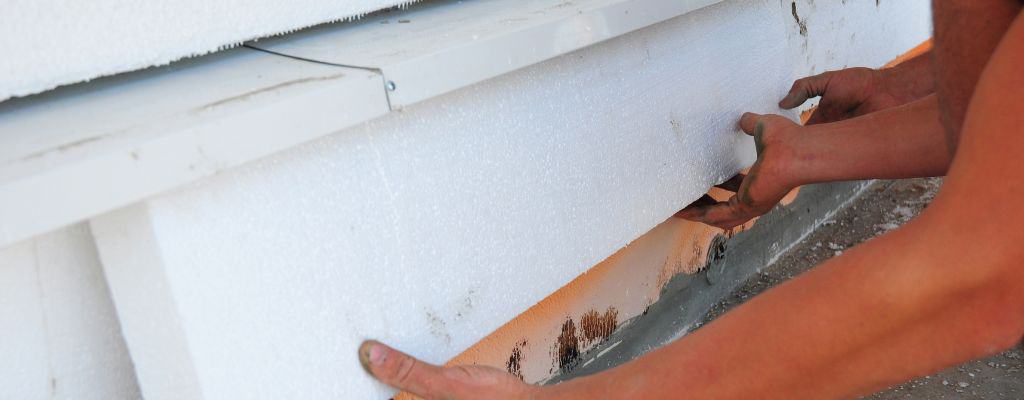
Foam Board Insulation
Foam board insulation consists of rigid panels of foam, often made from polystyrene, polyurethane, or polyisocyanurate. It provides good thermal resistance and can significantly reduce energy consumption when properly installed. These boards are lightweight, easy to cut and install, making them a popular choice for insulating walls, roofs, and foundations. They also provide some degree of sound dampening. However, they are not as effective in insulating against radiant heat compared to reflective foil insulation, and they may be more expensive.
Top Foam Board Product
The Matador Garage Door Insulation Kit is designed to provide an easy and cost-effective way to insulate your garage door, thereby increasing your home’s energy efficiency. The kit includes eight boards of high-impact polystyrene laminate which are easy to install with the included tools. Once installed, the insulation helps to keep your garage cooler in summer and warmer in winter, potentially reducing your energy bills. The Matador Kit is designed to fit standard garage doors and can be installed in less than an hour, making it a convenient choice for many homeowners.
Pros Of Foam Board Insulation
- High Insulation Value: Good thermal resistance per inch of thickness.
- Lightweight: Easy to handle and install.
- Moisture Resistant: Some types resist moisture and mold.
- Versatile: Suitable for various applications including walls, roofs, and garage doors.
- Sound Dampening: Can reduce noise transmission to some extent.
- Airtightness: Can contribute to airtightness if installed correctly, reducing drafts and energy loss.
Cons Of Foam Baord Insulation
- Cost: Can be more expensive compared to other insulation types.
- Environmental Concerns: Some foam boards are made from petrochemicals and may have a higher environmental impact.
- Flammability: Can be flammable and may emit toxic fumes when burned.
- Durability: Easily damaged by harsh impacts or pests.
- Installation Challenges: Incorrect installation can reduce effectiveness.
- Limited R-Value Stability: R-value can degrade over time in some foam insulations.
- Not Biodegradable: Disposal can be an issue as it doesn’t break down naturally.
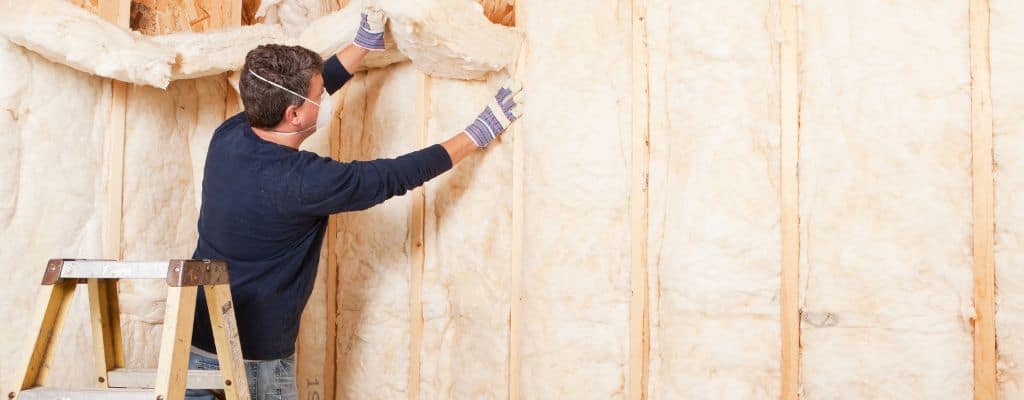
Batt Insulation
Batt insulation consists of pre-cut panels of fiberglass or rock wool insulation. It’s a common type of insulation used in walls, attics, and floors due to its ease of installation and effective thermal resistance. The batts are designed to fit snugly between the studs, joists, or rafters of a building, providing a continuous layer of insulation that helps to keep the building warm in winter and cool in summer. It also offers some level of soundproofing, making it a good choice for interior walls as well.
Top Batt Insulation Product:Reach Barrier 3009
The Reach Barrier 3009 Garage Door Insulation Kit is designed to block up to 95% of radiant heat, enhancing the comfort and energy efficiency of your garage. This kit includes eight panels of insulation and is easy to install, making it a convenient choice for homeowners looking to improve their garage’s insulation. Its design enables it to cover an 8×8 ft garage door, providing a barrier against heat transfer and helping to maintain a more comfortable temperature in your garage year-round.
Pros of Batt Insulation
- Cost-Effective: Generally less expensive than other insulation types.
- Ease of Installation: Pre-cut panels fit easily between studs and joists.
- Effective Insulation: Good thermal resistance.
- Soundproofing: Provides some level of sound insulation.
Cons Of Batt Insualtion
- Gaps and Spaces: Improper installation can leave gaps, reducing effectiveness.
- Health Concerns: Fiberglass batts can irritate skin and respiratory tract.
- Moisture Sensitivity: Can absorb moisture, potentially leading to mold issues.
- Less Effective: Lower R-value per inch compared to foam insulations.
Takeaway
In conclusion, selecting the right garage door insulation is a multifaceted decision influenced by your local climate, budget, and the insulation’s R-value, among other factors. Whether you opt for reflective foil, foam board, or batt insulation, each has its merits and drawbacks. By weighing these factors against your personal needs and preferences, you can enhance your garage’s thermal efficiency, contribute to a more comfortable living environment, and possibly lower your energy bills in the long run.
At Garage Door Repair we have years of experience helping homeowners repair and maintain their garage doors. Although maintaining your garage door can seem like a daunting task, it’s actually quite simple if you have the right knowledge and tools. In this guide, we will break down all the essentials of garage door maintenance, providing you with a step-by-step approach to keep your garage door in top condition.
Regular garage door maintenance is not just about keeping it operational; it’s about ensuring the longevity of your investment and safety for your home. Here, we share the secrets of professional garage door services to help you master the art of maintaining your garage door.
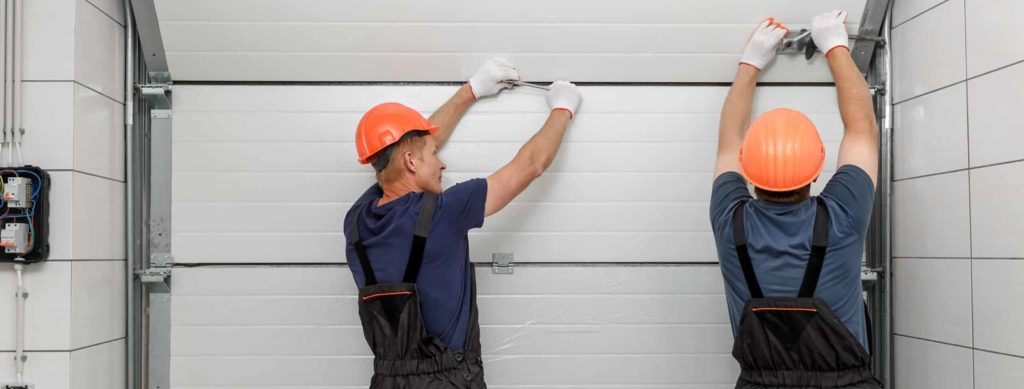
Why Garage Door Maintenance Matters
Your garage door is one of the most essential pieces of your home’s exterior, offering protection, insulation, and convenience. But, like any other mechanical system, it can wear out over time. By carrying out regular maintenance, you can significantly extend its lifespan, prevent unnecessary repairs, and ensure the safety and security of your home.
Unsure where to start? We’ve got you covered. Whether you’re a seasoned DIY enthusiast or a homeowner looking to learn more about maintaining your garage, our guide is designed to help you understand the intricacies of garage door maintenance
Understanding the Basics: Garage Door Tune-up
A garage door tune-up isn’t as complex as it sounds. This involves a series of inspections, minor repairs, and adjustments that ensure your garage door operates smoothly. A proper garage door tune-up can help identify potential issues before they escalate into major problems.
Start by visually inspecting your garage door. Look out for signs of wear and tear on the springs, cables, rollers, and pulleys. Remember, never try to repair the torsion springs yourself; they are under high tension and can cause severe injuries if handled incorrectly. Always seek professional assistance for spring-related issues.
Next, test the balance of your garage door. If your garage door is not properly balanced, the door opener will have to work harder, reducing its lifespan. To test the balance, disconnect the opener by pulling the release handle (usually a red cord), and manually move the door about halfway up. If it doesn’t stay put, the counterweight system (springs) is improperly balanced. If this is the case, you may need a professional to adjust it.
Garage Door Maintenance Preventative Measures
While understanding the basics of garage door maintenance and troubleshooting common issues are crucial, prevention is always better than cure. A preventive approach can help you avert garage door problems before they become substantial issues. Here are a few tips:

Regularly lubricate moving parts
Regular lubrication of the moving parts of your garage door is a crucial maintenance task. Lubrication reduces friction, which in turn helps the door operate smoothly and quietly, and extends the lifespan of the moving parts. Here are some guidelines:
Type of Lubricant:
Use a high-quality silicone or lithium spray lubricant. Do not use a heavy oil or grease, as these can collect dust and debris, leading to a sticky buildup that can cause issues over time. Avoid WD-40 for garage doors, as it’s a cleaner rather than a long-term lubricant.
What to Lubricate:
- Springs: These do most of the heavy lifting in your garage door mechanism. Spray them lightly, ensuring all parts have a thin layer of lubricant.
- Rollers: Apply lubricant to the rollers, but be careful not to get any on the track. Ensure the lubricant penetrates the rollers well. If your rollers are nylon, make sure to only get lubricant on the bearings as too much lubricant can degrade nylon over time.
- Hinges: Lubricate the hinges, paying particular attention to the hinge pivot points. However, avoid lubricating plastic parts as some lubricants can cause plastic to break down over time.
- Tracks: You should not lubricate the tracks, but you can clean them with a damp cloth. If they’re particularly dirty, you can use a solvent like brake cleaner. After cleaning, wipe them down with a dry cloth.
Keep the tracks clean
Clean the tracks on either side of the door to ensure they’re free from debris, which can obstruct the smooth movement of the door.

Test the Garage Door Balance
If your garage door is not properly balanced, the door opener will have to work harder, and it won’t last as long. To test the door balance, you need to disconnect the opener by pulling the release handle (usually a red cord), then manually move the door about halfway up. If it doesn’t stay put, the counterweight system (springs) are improperly balanced. This is a task for a professional.
Tighten Up the Hardware
Before you start tightening any hardware, it’s a good idea to visually inspect all the components of the door system to see if anything looks loose or out of place.
Track and Roller Brackets:Check all the brackets that hold the track to the wall and the brackets holding the rollers. These brackets are under high tension and are usually attached with a bolt and nut. If you find any that are loose, tighten them with a wrench.
Hinges:Check the hinges that hold the sections of the door together. If they’re loose, tighten them with a screwdriver. Be careful not to over-tighten, as this could strip the screw hole or damage the hinge.
Springs, Cables, and Pulleys:The springs, cables, and pulleys of your garage door are under a lot of tension and can be dangerous to adjust if you’re not experienced. If you notice any loose hardware in these components, it’s a good idea to call a professional to address the issue.
Garage Door Opener:If your garage door opener is mounted to the ceiling, check the mounting hardware, including the brackets and screws. Tighten any loose screws or bolts.

Inspect and Replace the Rollers
The rollers, whether steel or nylon, need to be inspected twice a year and replaced every seven years or so, and even more if you use your garage door many times a day. Worn, chipped, or cracked rollers should be replaced as soon as possible.
By replacing worn, chipped, or cracked rollers, you ensure the continued smooth and efficient movement of your garage door. This proactive maintenance measure not only prevents potential operational problems but also contributes to the overall safety and longevity of your garage door system.
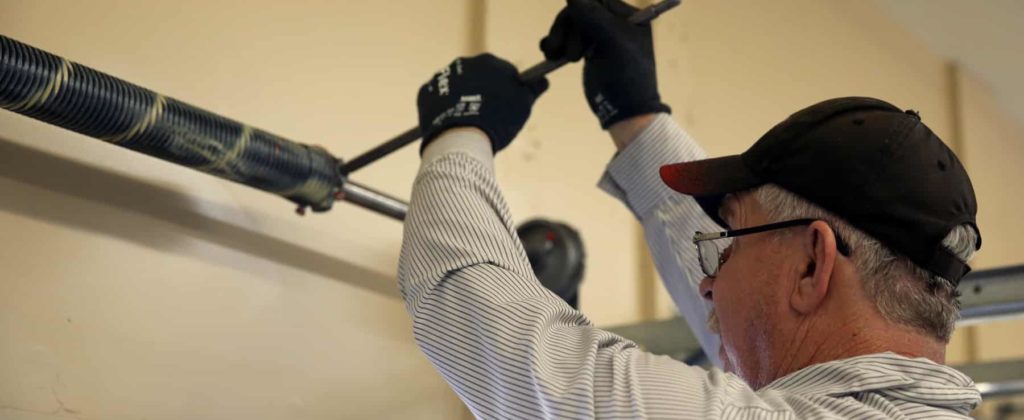
Check the Cables and Pulleys
High-tension cables, over time, can experience wear and tear due to the heavy loads they bear and the constant movement of the garage door. When cables become worn or weakened, they pose a significant risk as they may snap under the extreme tension. A snapped cable can lead to sudden and uncontrolled movements of the garage door, causing serious injury to people or damage to property.
To ensure the safety of you and your loved ones, it is imperative to have a professional technician inspect the cables and pulleys regularly. These trained experts possess the knowledge and experience to identify early signs of wear, fraying, or other forms of damage that could compromise the integrity of the cables.

Check the Auto-Reverse Safety Features
There are two mechanisms: mechanical and photocell. To test the mechanical feature, place a piece of wood or a brick on the ground in the path of the door. When the door coming down touches the object, it should reverse direction. To test the second, the photoelectric system with beams at each side, close your door and just pass your leg in the door’s path. Your door should reverse.

Schedule professional tune-ups
Even with regular at-home maintenance, having your garage door professionally inspected annually can help catch potential issues before they become serious. Contact Garage Door Repair today to schedule an appointment with our expert technicians. Experience the difference of professional service and restore your garage door to its former glory.
Troubleshooting Common Garage Door Problems
Despite regular maintenance, you may encounter some common garage door problems. Don’t worry, we’re here to help. Here’s how to handle some of these issues.
Garage Door Not Closing Properly
If your garage door doesn’t close all the way, there are several possible causes, such as misaligned sensors or obstructions in the garage door’s path. Learn more about what to do when your garage door won’t close all the way.
Manual Garage Door Operation
There may be times, due to power outages or mechanical issues, when you need to operate your garage door manually. Understanding how to do this safely is essential. Discover how to reset and open your garage door manually with our guide on how to reset a garage door after opening it manually.
Conclusion
Maintaining your garage door might seem like a daunting task, but with a little knowledge and regular attention, you can ensure it works smoothly for years to come. Remember, while DIY maintenance can handle minor issues, some tasks should be left to professionals. Our professional and friendly team at Garage Door Repair is always ready to assist you with all your garage door needs.
Garage door maintenance is a valuable task that not only ensures the longevity of your garage door but also contributes to your home’s overall safety and efficiency. Whether you’re a seasoned homeowner or just getting started, a well-maintained garage door is a cornerstone of a well-kept home.
A garage door may only be one part of your home’s features, but it can be a major inconvenience when it doesn’t function properly. Without it, you may find a garage vulnerable to the elements and potential intruders.
If your garage door won’t close, it’s best to understand what’s causing the issue and take the necessary steps to fix it. At Garage Door Repair, we look at your garage door’s role in keeping your home safe and secure and help you get it back on track.
Reasons a Garage Door Won’t Close All The Way
It can be frustrating when you can’t figure out why your garage door won’t close. If you’re currently dealing with this problem, here are some of the most common garage door-related damages and issues you should check on:
1. Obstructed Door
Garage doors work by using sensors to determine if an object is in the way of the door closing. If there is anything blocking the sensor, even if it’s not in the way of the door closing, this will cause the door to have issues closing.
There’s always a chance that something as simple as a piece of furniture could be getting in the way of your garage door. Take a look around or inside the garage to see if there are any potential obstructions.
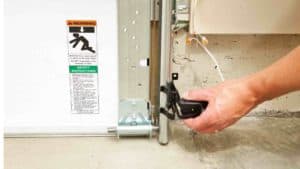
2. Malfunctioning and Misaligned Safety Sensors
Your garage door has built-in safety sensors. When garage doors close, these sensors detect any objects in the path of the garage and will stop the garage from closing. If these sensors aren’t working properly, your garage could be stuck open or unable to close completely.
Similar to the solution above, first check if anything is in the way of the sensor. If you have determined that nothing is blocking the sensor, it might be that the sensors themselves are out of alignment.
Here’s a simple way to check: take a look at the exterior LED light when you press the button to close the door. If the light is green, your sensors are in good shape. But if the light starts flashing red, that means the sensors need some attention. Don’t worry, it’s a quick fix! Just inspect the bracket or tighten a screw on the flashing sensor. Once you’ve done that, the red light should turn green, the flashing should stop, and your garage door should close smoothly once again
If this doesn’t fix the issue, it’s time to check the lens itself. Sometimes all it takes is a quick wipe with a clean cloth to get them back in working order. These sensors play a crucial role in keeping your garage door functioning smoothly, but dirt, spiderwebs, and other debris can cause them to fail.
By simply giving the lenses a quick cleaning, you can ensure that your door operates without a hitch. If you live in a particularly dusty area, make sure to give your sensors a regular clean to keep them functioning perfectly.
Lastly, check the wires connecting your garage door to its sensor. Your garage door sensor system’s wires are your trusty connection to the outside world, but with all the wear and tear from regular use, inclement weather, and even pesky critters, they might start to show signs of wear and tear.
Don’t worry, though! If you see any signs of water damage, chew marks, or other suspicious tampering, you can easily replace the wires and keep your garage door sensor system in tip-top shape.
3. Damaged Springs
There are two main types of garage door springs, extension and torsion. Extension springs are mounted on the sides of the track, extending and contracting when the door is in motion. Torsion springs on the other hand run horizontally and hold two cable drums at each end – the torsion spring plays a crucial role in the smooth opening and closing of your garage door.
Although they are different, they serve the same purpose. Storing tension when the door is closed and releasing it when you lift the door open.
This means that most of the time, your garage door springs are under tremendous tension. Overtime materials will break down and eventually the springs will break.
If this has happened to you, don’t worry, the pros at Garage Door Repair know how to fix it and will have your garage door springs working in no time at all.
Additionally, if you do decide to take on the project yourself, the video below provides a wonderful explanation on how to do so.
4. Damaged Cables
Depending on the type of spring system your garage door uses, extension or torsion, the location of your cables will change.
In the case of a torsion spring system, the cables are connected to the door drum on each side of the shaft and work by rotating a winding cone to lift the door. When the door lowers, the process reverses.
On the other hand, the cables on an extension system are located inside the springs a to prevent any broken spring pieces from causing damage or harm.
Your garage door cables are hardworking components that help you open and close your garage door smoothly and effortlessly. However, just like anything else that’s used repeatedly, they can experience wear and tear and eventually break.
Age, rust, incorrect installation or configuration, and even an accidental bump can all contribute to the breakdown of your garage door cables. Fraying and pulley wear are also common issues.
Regular maintenance, careful usage, and quick repairs can help prolong the life of your garage door cables and keep your garage door functioning at its best.
If you have found yourself with broken door cables, be sure to reach out to a professional installer who can safely secure your garage door for years to come.
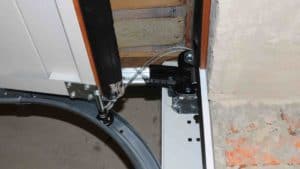
5. Damaged Tracks
Fixing a bent garage door track may seem like a DIY project, but it’s best to call in the experts. Trying to fix it yourself with tools and videos may only lead to bigger problems and even injury.
The professionals have the expertise and equipment to get the job done right, ensuring a smooth and safe operation for your garage door. Don’t risk making things worse, leave it to the experts to get your garage door back to its best.
Fix Garage Door Problems With Garage Door Repair
When a garage door won’t close, homeowners naturally want to fix the issue themselves. You can clear the way, set the limits, and clean and lubricate the parts. It’s possible, but garage door repairs require specialized tools and expertise. Depending on why your garage door won’t close, you can take the matter into your own hands or call garage door specialists for help.
If it’s simply a blockage or misaligned safety sensors, you can usually troubleshoot and solve the issue on your own. But if it’s beyond your skill set, it’s time to call the professionals. At Garage Door Repair, we work with professionals who identify the problem, fix it quickly, and get your garage door working again in no time.
We help homeowners with garage door issues of all kinds. Whether you need garage parts, replacements, or other garage door services, we can help. Your garage door is vital to your home and family’s security, so let’s help you make the most of your investment. Contact us now!
How to Know When It’s Time to Repair or Replace Your Garage Door
Out with the old, in with the new! That’s one way to look at things, but while familiar sayings may ring true, there’s usually more to decision making than that. The important thing to remember is that any time you have to make a choice there are several things to consider, things unique to you and your set of circumstances. Evaluating your wants, needs, and desires, tempered with practical considerations, can help you get the best results. Your garage door is damaged. Sure, you want the door to work properly. You need to be able to live and work as you did before. And like most people you desire the best, newest, safest, quietest garage door available. There are several ways to approach this.
Signs You May Need a Replacement
Example #1: Car versus door leaves you with a dented section.
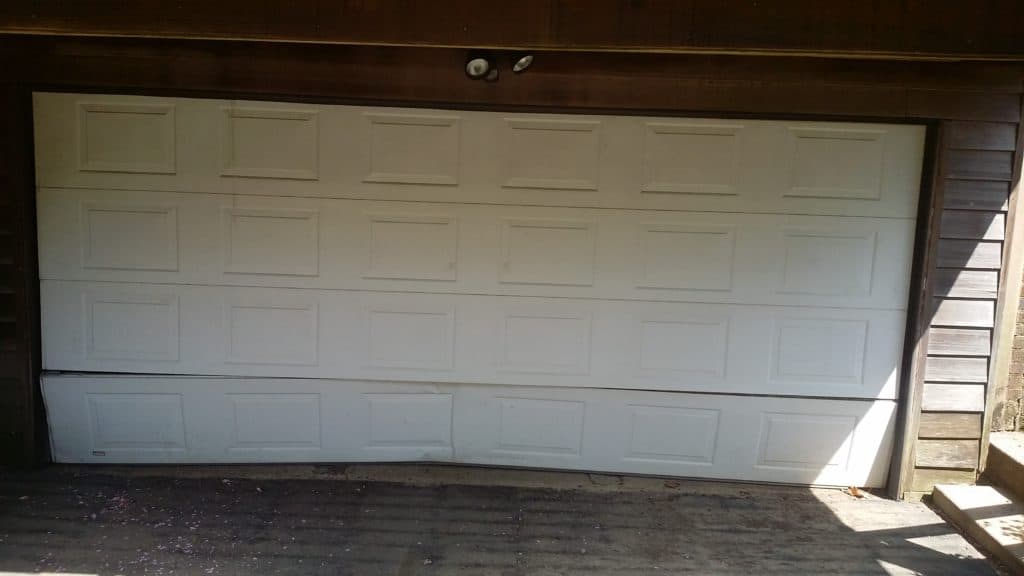
Some considerations:
- Proper, safe, section replacement by homeowners is usually not practical. In many cases a section replacement may be half the price of a new door.
Get a new door. This gives you a chance to have the latest features, perhaps better insulation, new color choices, better weatherstrip, maybe a row of windows. You’ll have a new warranty too. - What if you have two doors on your garage and the new product won’t match the old? As well, a replacement section may not look exactly the same as the rest of the door due to the natural fading which, depending on the age and location of the door could be very noticeable.
- If the door has had a lot of use, wear parts like rollers and cables may cause trouble and expense in the future.
- Have you had a number of service calls in the past? Springs have a limited life and can fail after a specified number of cycles–maybe not long after you replace the damaged section.
- How old is the door? How old are you? (Sounds funny, but consider this for all major purchases.)
- Do you plan to stay in the house?
- What was the condition of the door before it was hit? Have you already had a service call because of the accident?
Signs You May Only Need a Repair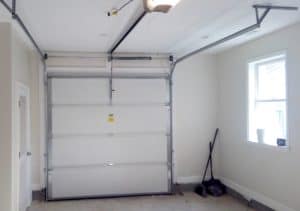
Example #2: The door does not work properly.
Some considerations:
- Inspect the door, inside and out, for obvious defects like broken cables or springs.
- While the door is in the down position, disconnect it from the operator, if applicable. Open the door. If it is heavy, or noisy, return it to the closed position and lock it in place. Have your Garage Door Repair technician check the door.
- If there are major problems, the same principles shown above apply: How old is it, overall condition, how often it’s used, your plans to stay in the house, etc. In many cases a simple repair is the best way to go.
- The door may not be connected to the operator drawbar arm.
Example #3: Your operator is not working.
Some considerations:
- There may be loss of power to the unit.
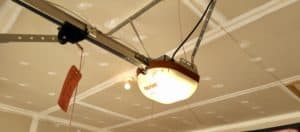
- Photo eyes may be dirty or out of alignment. Note: that service technicians will not repair any operator that does not have external safety devices, such as photo eyes, making total operator replacement the only option available to the homeowner.
- There could be an obstruction in the opening.
- The problem may be with the door, not the operator.
- The low voltage wiring to the wall button may be loose or broken.
- Transmitter batteries may be weak. Light bulb replacement is an easy task.
- With an operator, the age of the unit is a major consideration since there is ongoing improvement in the technology available that gives owners more convenience and security than ever before. Unless there is a very simple fix, operator replacement and the benefits to the homeowner make this an easy choice.
Let Us Help
Decision time. Ask yourself what’ll you have when the job is finished. In summary, because of the tools and techniques needed there’s little a homeowner can safely do to fix a door problem, so whether to fix an existing door/operator, or installing new equipment is a question of value. Calculate this by looking at the facts, list the pros and cons and see what will be the best choice for you. Often one of these–the pros or cons–will far outnumber the other.
At GarageDoorRepair.com, we connect you with local garage door repair experts from around the country. Find a locally licensed company with highly-trained technicians who can provide garage door repair replacement services in both commercial and residential settings.
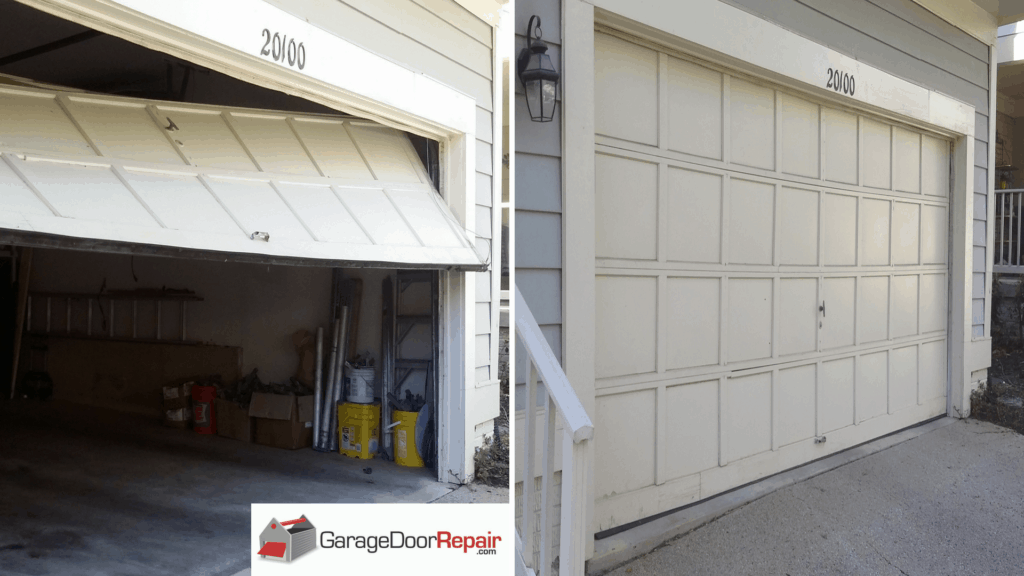
Considering DIY Garage Door Repair?
Here are a few reasons you might want to reconsider…
A sign in a Pennsylvania bicycle repair shop reads:
LABOR RATE
$ 50.00 per hour
$ 75.00 if you watch
$ 100.00 if you help
$ 200.00 if you worked on it first
There’s a lesson here and it is that the bicycle repairman has learned from years of experience that some things are more complicated than they look, more dangerous, and in the long run, more expensive. DIY attempts to perform door work might well carry the familiar warning ‘don’t try this at home’.
Of course homeowners can and should inspect their doors, apply lubrication, and look for obvious signs of wear. This includes things like listening to doors and operators in motion, or checking to see if the perimeter weatherstripping is doing the job, all the while using common sense as you would with any large moving object.
List of safe DIY Garage Door Inspections
- Park your vehicles outside, close the door and see if it moves smoothly.
- Disconnect the door from the operator and move it by hand. Does it stay closed? Does it drift down from the open position?
- Look to see if it sits level on the garage floor.
- Does it clear the header when in the fully open position?
- Check to see if the photo eyes are clean and properly aligned.
- Inspect the sections inside and out; worn or damaged sections can mean that the door no longer provides security for the home, and could cause property damage and serious bodily injury.
- Is the operator plugged in correctly?
- Make sure the track is fastened securely to the jambs, look for frayed cables, broken springs, worn rollers, and loose fasteners.
Be mindful of the fact that to the untrained eye it’s easy to miss something that is worn, loose, or broken.
Doing these things should be a regular part of household maintenance. If you are handy around the house go ahead and snug up a loose fastener, tap that nail that holds the weatherstrip to the jamb, clean and lube the door as necessary. When a serious problem arises, however, it’s best to turn to an expert for help.
3 Serious Reasons to reconsider DIY Garage Door Repair
- Tools. An experienced garage door repairman will have the proper ladders, specialized tools, and the correct parts needed to fix most problems. He will also have things the homeowner won’t have and can’t buy at a big box store: cold rolled steel winding bars of various sizes, aircraft cable, special cable pulleys, operator parts, spring stock and gauges, torches and much more. Hammers, screwdrivers and pliers are good for small jobs around the house, but of little use, and can cause injury, when performing proper garage door repairs.
- Training. Another consideration is that with overhead garage doors things must be done in the proper order. What’s the first step to take to adjust, replace, or wind a spring? Are repairs made with the door in the open or closed position? How would you attach a new cable to a spring, drum, or bottom fixture? If you attempted to do the work yourself, how would you test it to see if it was okay? Tested it safely, that is. The garage door spring is among the most dangerous repairs and can result in serious injury, or even death, if not done correctly.
- Ladders. It sounds simple, however, each year thousands of people are injured or killed in home-related accidents. And, almost without exception, the number one leading cause is always falls. The Home Safety Council says falls account for roughly 6,000 deaths annually. While you’re always susceptible to a fall, you should do everything you possibly can to avoid situations where falls are particularly dangerous. This includes climbing ladders to fix garage door issues.
The old definition of an expert was someone who came from more than 50 miles away and was carrying a briefcase. Mark Twain joked that an expert was just a regular fellow from the next town over. Our factory trained technicians are close at hand, have a truck full of parts and specialized equipment and have something else in their tool kits – Safety. In most trades, a pinch, a cut, and a bump on the head are all common on-the-job injuries, and as a result workers quickly learn from experience how to do things the right way, the safe way. In our business training and experience are top priorities.
Safety is a serious concern at all large major companies. Some multi-national corporations go so far as to cease production at every facility they own if there is an accident with injury anywhere in their system. Full reports and appropriate instructions are sent to all parties at every location and orders are issued before operations are resumed. That’s serious. Being safe is a priority for them and good word of advice for a homeowner.
If you decide to do the work yourself remember that you can fall, and things can fall on you. As well, DIYers working on a garage door can and do sustain cuts, bruises, broken bones, eye injuries, even electrical shocks, all as result of not having the right tools, parts, and experience.
Above all else, safety is the key factor in making the decision to use a professional.
Be safe, DDIY. Contact Your Local Garage Door Expert Today.



